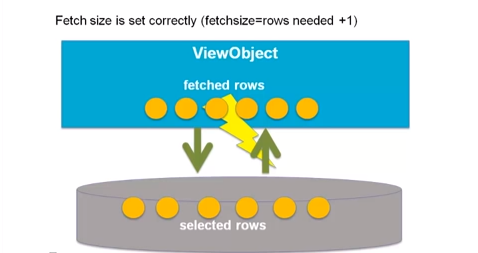Following are some of the important points to increase the performance of your ADF Application.
1. In view object tuning section always set the fetchSize to value which will be greater than the no of rows you are showing on the grid
Because
Default fetchSize is 1 with this fetch size for each row it goes to DB and fetch the records, that is one by one as shown in above diagram.
I you want to increase the performance set some value for this fetchSize attribute so that it will fetch the rows in batches.
If you are showing 10 rows in a grid then in that ViewObject set fetchSize as 11 (row needed+1). FetchSize is nothing but how many rows have to be fetched from DB in one trip.Using this no of Db trips will be reduced.
2. Remove unwanted bindings from pagedef and refresh conditions on iterator(only keep the required value of this property).
3. Activation and Passivation :
- when you run your ADF application first time,bydefault ADF creates PS_TXN table in the schema to store the details
- Do not passivate the state of a transient attribute in ViewObject. If you include all transient attribute from tuning section then all the calculated and transient attributes will be passivated and when the session state is reloaded they are activated .
Best practice is,if you need specific attribute then you can do this by using the attribute property editor and select the passivate check box.
5.Set partialSubmit="true" wherever it is possible on buttons,links,menu items.It will refresh only part of the page and not the whole page and increases the performance.
6.In ViewObject use the Access mode as RangePaging instead of Scrollable.
The main difference is if you use scrollable it keeps all the rows fetched from the DB in to the memory as you scroll down but in case of RangePaging it stores only those rows in memory which we are seeing on the screen and it will avoid the heavy uses of memory for Data.
7. Use small memory scopes for beans.
8. Make the ids of components as small as possible.
for folowing component the ids should be of max 2 characters.
<af:pageTemplate>
<af:region>
<af:panelCollection>
<af:table>
<af:treetable>
<af:tree>
<af:iterator>
Because these are container components and Child components use their parent component id.
This is good for browser performance.
9. Use the following steps to optimize your application performance
In BC ->
- Detect and tune the VO's slow queries.
- Setting the appropriate tuning-values on the VO.
- Use VO RangePaging if the table rows > 300.
- Use lazy loading on AM's
- Sizing the application module pool.
10. Set the proper JVM heap size and choose an effective garbage collection strategy.
1. In view object tuning section always set the fetchSize to value which will be greater than the no of rows you are showing on the grid
Because
Default fetchSize is 1 with this fetch size for each row it goes to DB and fetch the records, that is one by one as shown in above diagram.
I you want to increase the performance set some value for this fetchSize attribute so that it will fetch the rows in batches.
If you are showing 10 rows in a grid then in that ViewObject set fetchSize as 11 (row needed+1). FetchSize is nothing but how many rows have to be fetched from DB in one trip.Using this no of Db trips will be reduced.
2. Remove unwanted bindings from pagedef and refresh conditions on iterator(only keep the required value of this property).
3. Activation and Passivation :
- when you run your ADF application first time,bydefault ADF creates PS_TXN table in the schema to store the details
- Do not passivate the state of a transient attribute in ViewObject. If you include all transient attribute from tuning section then all the calculated and transient attributes will be passivated and when the session state is reloaded they are activated .
Best practice is,if you need specific attribute then you can do this by using the attribute property editor and select the passivate check box.
5.Set partialSubmit="true" wherever it is possible on buttons,links,menu items.It will refresh only part of the page and not the whole page and increases the performance.
6.In ViewObject use the Access mode as RangePaging instead of Scrollable.
The main difference is if you use scrollable it keeps all the rows fetched from the DB in to the memory as you scroll down but in case of RangePaging it stores only those rows in memory which we are seeing on the screen and it will avoid the heavy uses of memory for Data.
7. Use small memory scopes for beans.
8. Make the ids of components as small as possible.
for folowing component the ids should be of max 2 characters.
<af:pageTemplate>
<af:region>
<af:panelCollection>
<af:table>
<af:treetable>
<af:tree>
<af:iterator>
Because these are container components and Child components use their parent component id.
This is good for browser performance.
9. Use the following steps to optimize your application performance
In BC ->
- Detect and tune the VO's slow queries.
- Setting the appropriate tuning-values on the VO.
- Use VO RangePaging if the table rows > 300.
- Use lazy loading on AM's
- Sizing the application module pool.
10. Set the proper JVM heap size and choose an effective garbage collection strategy.






Comments
Post a Comment